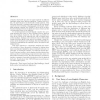Free Online Productivity Tools
i2Speak
i2Symbol
i2OCR
iTex2Img
iWeb2Print
iWeb2Shot
i2Type
iPdf2Split
iPdf2Merge
i2Bopomofo
i2Arabic
i2Style
i2Image
i2PDF
iLatex2Rtf
Sci2ools
78
Voted
AUIC
2005
IEEE
2005
IEEE
Aiding Text Entry of Foreign Alphabets with Visual Keyboard Plus
Computer keyboards are used to input hundreds of different languages using many different alphabets. Despite this diversity, the physical layout of keyboards is fairly uniform, with keyboards generally containing approximately 80 keys spread across six rows (excluding cursor keys and numberpad). In English speaking countries, the QWERTY layout is the de-facto standard binding between the physical location of keys and the corresponding letters of the alphabet. To aid international and multi-lingual computer use, operating systems allow users to alter bindings between physical keys and resultant characters, but this raises a problem for users as the labels on the physical keys will not match those of the bindings. Software user interfaces such as Microsoft’s Visual Keyboard (MVK) help users by providing a visual depiction of the keyboard’s new bindings, but users still suffer an overhead in establishing the mapping between the physical and displayed keys. This paper describes a c...
| Added | 24 Jun 2010 |
| Updated | 24 Jun 2010 |
| Type | Conference |
| Year | 2005 |
| Where | AUIC |
| Authors | L. Rennie, Andy Cockburn |
Comments (0)

